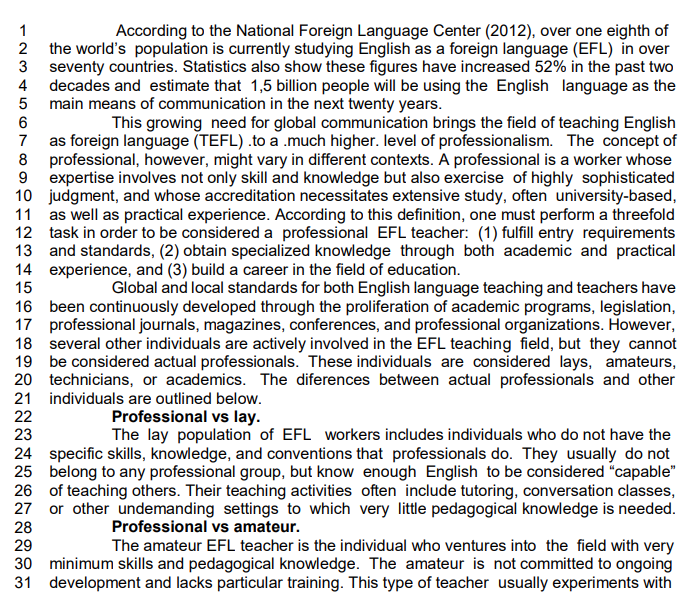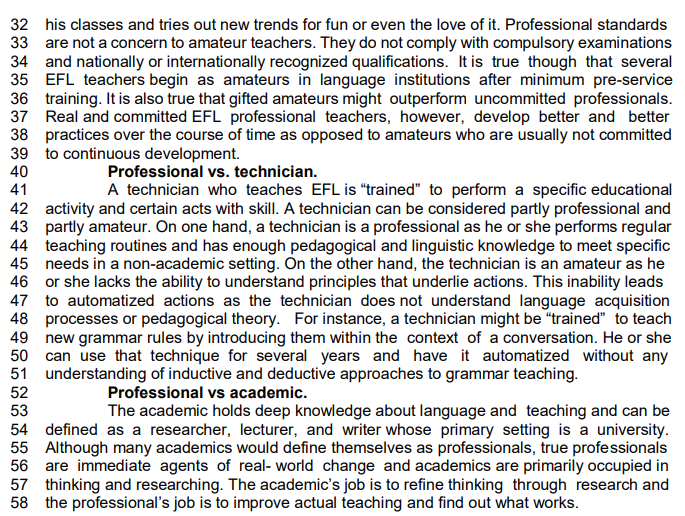Questões de Concurso
Sobre pronúncia e som | pronunciation and sound em inglês
Foram encontradas 163 questões
The teacher presents the following sentences to her students for analysis:
I'll read the book tomorrow.
He read the book yesterday.
The wind blew fiercely through the open window.
She had to wind the clock before going to bed.
After discussing the examples, the teacher asks the students:
Which of the following activities would best help learners understand and differentiate homophones and homographs in practical language use?
“The professional of Teaching English as a Foreign Language”
Author: Anderson Francisco Guimarães Maia


“The professional of Teaching English as a Foreign Language”
Author: Anderson Francisco Guimarães Maia


How do most teachers use micro-dictations?
However ‘small’ they are, micro-dictations have great value! They can help students notice connected speech, which is what usually blocks their understanding in a listening lesson. The teacher reads the sentences or plays the recording. They repeat each sentence a few times. Example: He must have gone out.
Students listen and write what they hear.
The teacher now writes the sentence on the whiteboard and asks students to compare it to theirs.
Finally, the teacher asks: which part was difficult to understand and why?
TSATERI, Rachel. World of better learning. Disponível em: https://www.cambridge.org/elt/blog/2023/06/11/using-micro-dictations-to-helpstudents-notice-connected-speech/. Acesso em: 12 jul. 2024. Adaptado.
O texto acima discorre sobre como os professores podem usar micro-dictations. Qual das estratégias abaixo corresponde a uma técnica de micro-dictation?
Atenção! Leia o texto a seguir para responder à próxima questão.
Ain't It Fun
I don't mind
Letting you down easy, but just give it time
If it don't hurt now then just wait, just wait a while
You're not the big fish in the pond no more
You are what they're feeding on
So what are you gonna do
When the world don't orbit around you?
So what are you gonna do
When the world don't orbit around you?
Ain't it fun?
Living in the real world
Ain't it good?
Being all alone
Where you're from
You might be the one who's running things
Where you can ring anybody's bell and get what you want
See it's easy to ignore trouble
When you're living in a bubble
(…)
WILLIAMS, Hayley; YORK, Taylor. Ain’t it fun. Disponível em: https://www.musixmatch.com/lyrics/Paramore/Ain-t-It-Fun. Acesso em: 12 jul. 2024. Adaptado.
Atenção! Leia o poema a seguir para responder à questão.
Twinkle, Twinkle, Little Star
Twinkle, twinkle, little star,
How I wonder what you are!
Up above the world so high,
Like a diamond in the sky.
When the blazing sun is gone,
When he nothing shines upon,
Then you show your little light,
Twinkle, twinkle, all the night.
Then the traveler in the dark
Thanks you for your tiny spark,
How could he see where to go,
If you did not twinkle so?
In the dark blue sky you keep,
Often through my curtains peep
For you never shut your eye,
Till the sun is in the sky.
As your bright and tiny spark
Lights the traveler in the dark,
Though I know not what you are,
Twinkle, twinkle, little star.
TAYLOR, Jane. Twinkle, Twinkle, Little Star. Disponível em: https://www.classicalmusic.com/articles/what-are-the-lyrics-to-twinkle-twinkle-little-star. Acesso em: 11 jul. 2024. Adaptado.
In the dark blue sky you keep, And often through my curtains peep, For you never shut your eye Till the sun is in the sky.
A estrofe vencedora do concurso, cujo criador seguiu corretamente as exigências indicadas, foi
Atenção! Leia o poema a seguir para responder à questão.
Twinkle, Twinkle, Little Star
Twinkle, twinkle, little star,
How I wonder what you are!
Up above the world so high,
Like a diamond in the sky.
When the blazing sun is gone,
When he nothing shines upon,
Then you show your little light,
Twinkle, twinkle, all the night.
Then the traveler in the dark
Thanks you for your tiny spark,
How could he see where to go,
If you did not twinkle so?
In the dark blue sky you keep,
Often through my curtains peep
For you never shut your eye,
Till the sun is in the sky.
As your bright and tiny spark
Lights the traveler in the dark,
Though I know not what you are,
Twinkle, twinkle, little star.
TAYLOR, Jane. Twinkle, Twinkle, Little Star. Disponível em: https://www.classicalmusic.com/articles/what-are-the-lyrics-to-twinkle-twinkle-little-star. Acesso em: 11 jul. 2024. Adaptado.
I. I don’t eat meet, I’m a vegetarian.
II. I like to hang outch with my friends on the weekends.
III. I always listen to music while I take a shower. IV. I have brekfast in the morning with my parents.
As frases que precisam ser corrigidas por apresentarem termos grafados incorretamente são:
Group 1 would- could-took-crook-food-facebook-push-put
Group 2 drawer-door-explore-dinosaur-before-folklore-your-more